Australia has some of the most fascinating fauna in the natural world, with big, bold, and bright flowers to delight gardeners and garden designers alike. So why do we forego our much-loved shrubs in place of non-natives and cultivated hybrids?
Well, I for one don’t think we should. Growing your own Australian bushes is simple, rewarding, and a great way to bring wildlife into your garden. Embrace your native plants with this guide to growing, and choosing the best varieties of Australian natives for your garden.
More...
What are Australian Bushes, and How to Use Them in Our Garden?
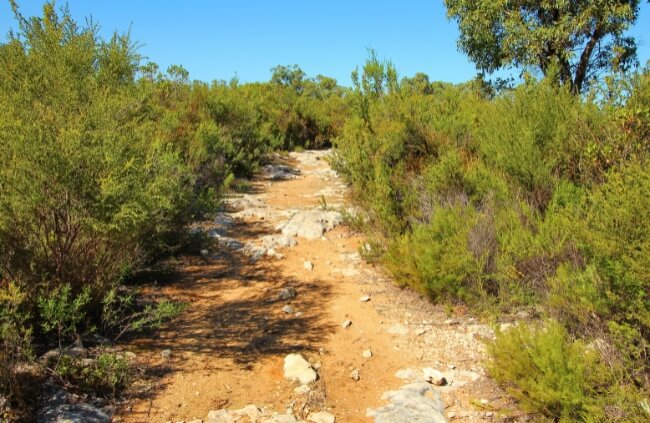
There are dozens of varied genera of shrubs and bushes all over Australia, from the coastal ground covers to towering acacias, so there’s something to suit every garden growing naturally on our own shores.
Bushes, a general name for shrubs, are woody-stemmed plants that hold their structure through winter and sprout from established growth. Some plants will remain evergreen all year round, while others lose their leaves.
Some Australian bushes can reach up to 8m tall, and others grow beautifully as prostrate plants closer to the ground. Not all produce significant flowers, but nearly all of them offer something for wildlife, whether it’s matted shelter or rich pollen.
Benefits of Planting Australian Bushes at Home
Because native plants have evolved to be pollinated by native bees, butterflies and birds (and sometimes mammals) they are the best way to encourage biodiversity in your garden.
Encouraging biodiversity doesn’t just boost your mood when you’re in the garden either, it has benefits for pest control, and reducing non-native insects. Predatory and parasitic wasps reduce unwanted pests, and ladybugs, attracted to large open flowers (bountiful on our native shrubs) make light work of aphids.
They also know how to cope on our soil. OK, so Australia has very varied soil conditions depending on where you are, but most of our gardens experience hot, dry, summers, damp humid autumns, and reasonably warm winters.
Australian plants help to maintain the soil, with roots that help to maintain its structure and prevent heavy clays from becoming arid. Acacia is perhaps the most famous for this, by actively improving nitrogen levels and soil structure where they grow.
Considerations for Growing Australian Native Shrubs
No, it might sound easy. Choose a native shrub, and it should grow. Right? Not necessarily. Australia is a big place. Soils and climates vary hugely, and the plants that grow in NSW are very different from those that grow in WA.
Check out your garden’s soil conditions, and assess where light and shade fall throughout the day. That will give you a good indication of what can grow in your garden.
How to Grow Australian Bushes
Australian natives are pretty straightforward to grow. Get the soil right, find the right spot, with just the right amount of light, and water them in generously. Once they’ve established themselves, there’s not much that can go wrong.
In fact, it is significantly easier to grow Australian natives than most other shrubs and bushes. That’s because plants that have evolved here, have evolved to cope with the pests we have.
Yes, some will have specific pest species that rely on them as a food source, but they will suffer less from climate-related problems, or soil-borne funguses. If grown on the right soil, Australian native bushes need less watering, less feeding, and less general care than non-native bushes too.


Get Your Free Guide:
Master Growing Australian Natives eBook
A Must Have Complete Guide for Every Australian Garden
Get Your Free Guide:
Master Growing Australian Natives eBook
A Must Have Complete Guide for Every Australian Garden
15 Australian Bushes to Choose From
Australia boasts some of the world's most ornamental natives. Many are common garden plants, but we’re on a mission to bring more back into popular use.
Every one of the native bushes below will grow in nearly all Australian gardens.
1. Grevillea

All but three species of Grevillea are native to Australia. These gorgeous shrubs, perhaps better known as spider plants to many, grow in any well-drained spot. They prefer full sun but provided they are warm, with reasonable irrigation and dry winters they can cope with light shade,
To learn more about grevilleas, explore our comprehensive Grevillea growing guide
2. Banksia
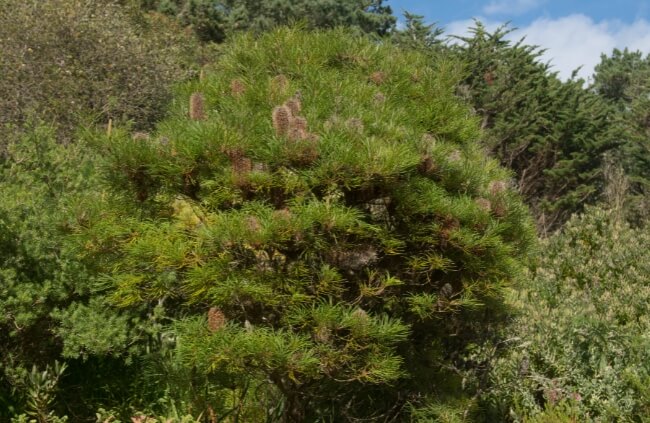
Every species of Banksia is native to Australia. Species are split between trees and shrubs, but all can be managed as bushes either by coppicing or pruning twice a year after flowering.
In warmer parts of the country, with regular summer irrigation, some species can flower for twelve months of the year. One brilliant perk of these highly attractive flowering bushes is that banksia flowers are edible.
For expert advice on tending to banksias, dive into our detailed Banksia growing guide.
3. Acacia
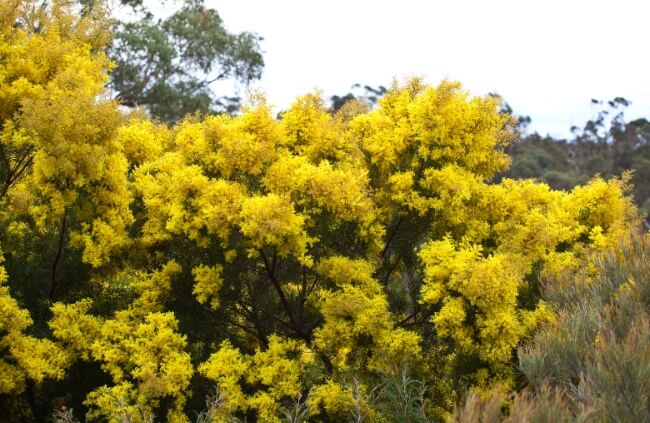
Not all Acacia species are native to Australia, but nearly all grow well in our gardens. Native acacias tend to be tree forms, but regular pruning can keep wattles in check and actually extend their lives.
Acacia are relatively short-lived trees thanks to quite brittle wood, but they vastly improve soil structure and draw nitrogen in from surprising distances to feed the garden around them.
Get to know how to grow and care for acacia in our comprehensive Acacia growing guide.
4. Callistemon
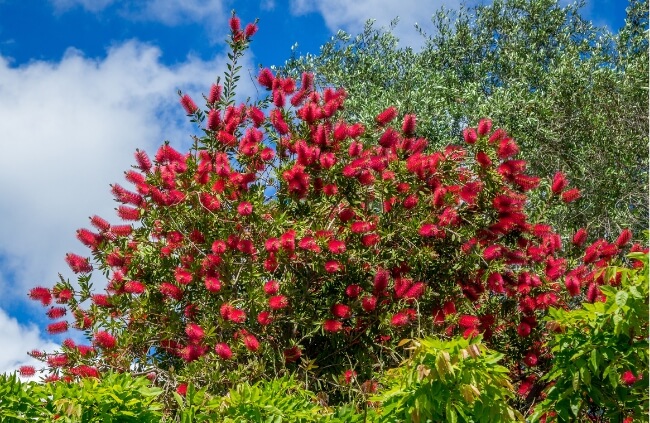
Callistemon is a surprisingly hardy plant and a great choice for more exposed gardens, or those that regularly experience winter frosts. Native Callistemon, also called bottlebrush, have fiery flowers that grow on fine new growth, so the more you prune, the more it flowers.
For more information on caring for bottlebrush plants, read our full Callistemon growing guide.
5. Lilly Pilly
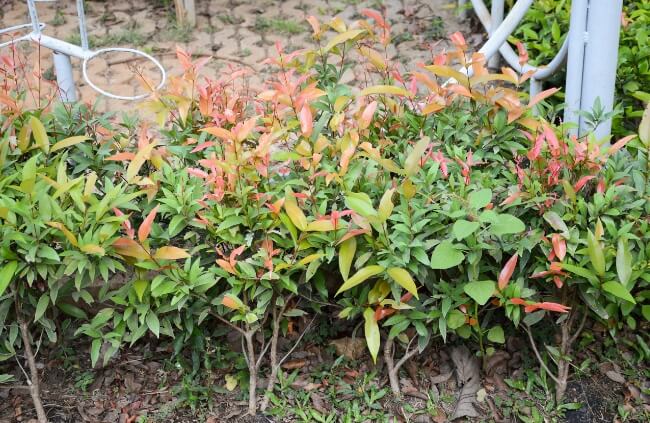
Lilly Pilly is one of Australia’s favourite hedges, but it makes an outstanding standalone bush. As a member of the Myrtle family, it is reasonably resistant to pests, and will generally grow into a full-sized 6-8m tall tree if left unchecked.
However, with regular pruning, this winter-fruiting evergreen can be used to form topiary or loosely pruned statement shrubs.
Discover how to properly nurture Lilly Pilly in our extensive Lilly Pilly growing guide.
6. Correa
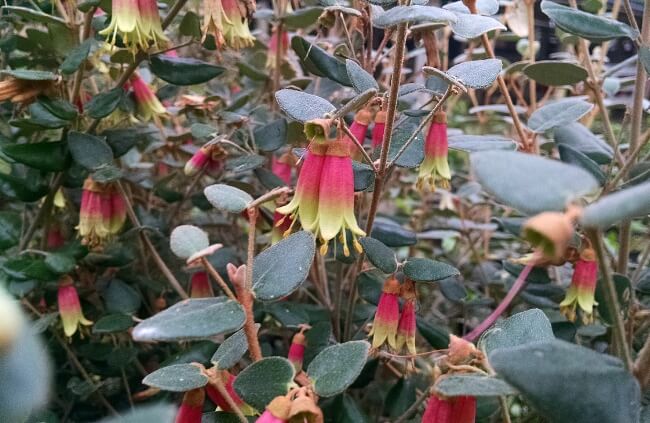
A distinguishing feature of Correa is its elongated flower, forming into neat, four-petalled tubes. There are variations in flower form and colour between species but they are generally creamy with pink highlights.
The tight foliage can be pruned easily with secateurs but as a relatively slow-growing Australian bush, Correa makes a great low-maintenance choice for less formal gardens.
Find out more about Correa with insights from our detailed Correa growing guide.
7. Eremophila
Eremophila is a large genus of small trees and shrubs, all native to Australia, and mostly native to arid parts of Western Australia. They make exceptionally lovely ground cover bushes, thanks to fine leaves that create tight mats of typically silvery foliage, paired with small but perfectly formed bell flowers.
Even tree forms are small enough to grow as bushes, with minimal pruning, and a good response to hard pruning if necessary.
8. Adenanthos

Source: Lullfitz Nursery
Woolly bush, or Adenanthos, is one of the most unique shrubs in the world, with foliage and stems so fine that they look almost herbaceous. That gentle, cloud-like, structure of Adenanthos provides the freshness of hardy herbaceous plants, combined with the stability and reliability of shrubs.
For the most vibrant spring and summer greens, paired with stunning acid yellows, prune woolly bushes back by about one-third each year. They can be grown like this as a hedge or a stand-alone bush.
Be an expert on growing Adenanthos by reading our full Adenanthos growing guide.
9. Melaleuca
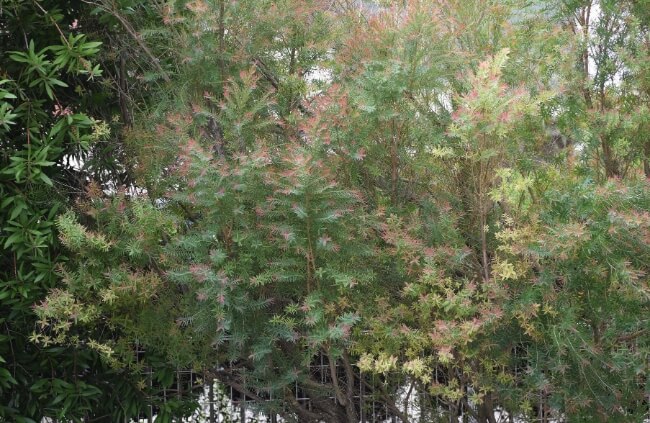
Honey myrtle, or Melaleuca, boast intense nectar reserves and highly fragrant foliage, which both protects them from pests and attracts pollinators and pollinating birds. Of all the low-maintenance Australian bushes out there, Honey Myrtle is the one with the most to offer.
Its structural habits are easily manageable, and once established into a bush, or hedge it will hold its form for years with minimal pruning, though some species do develop into more vigorous trees.
For more information on about this plant species, read our full Melaleuca growing guide.
10. Waxflower
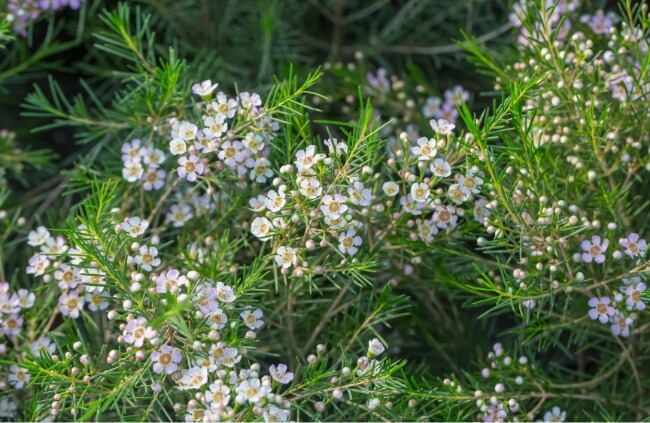
Waxflower (Chamelaucium) is another member of the myrtle family, but aside from the flowers, it shares little resemblance to its many cousins. The most commonly celebrated trait of Waxflower bushes is their longevity as dried flowers, but they are never better or more impactful than they are in the garden.
In full bloom, when their deep-green rosemary-like foliage is at its best, its dense clusters of flowers with deep pinks on their petals and rich yellows in their centres, are just breathtakingly beautiful.
They are simple Australian bushes to maintain too, provided they have as little irrigation as possible and very good drainage.
For more details on caring for wax flower, read our comprehensive Wax flower growing guide.
11. Eucalyptus
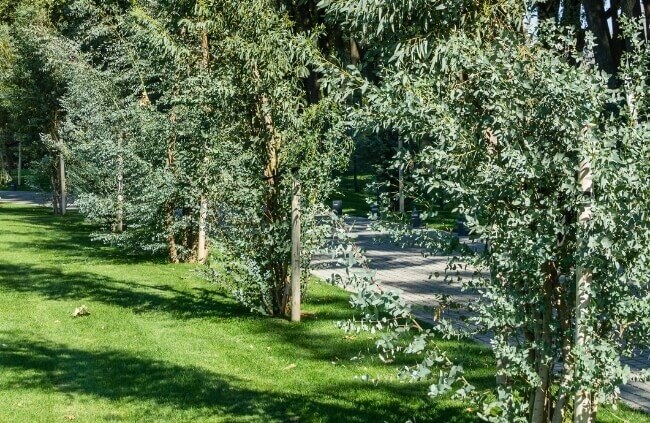
Eucalyptus are nearly all trees, but there are a handful of low-growing and dwarf cultivars that fare well in gardens. For the most part, if you want to grow eucalyptus as a bush, or hedge, it will require annual coppicing to maintain its height and to promote denser foliage.
Many eucalyptus share the same requirements (good drainage, full sun, and minimal water) but some, like Eucalyptus gunnii, prefer cold winters and more distinct seasonal changes, making them great candidates as bushes in cooler or more exposed Australian gardens.
12. Olearia
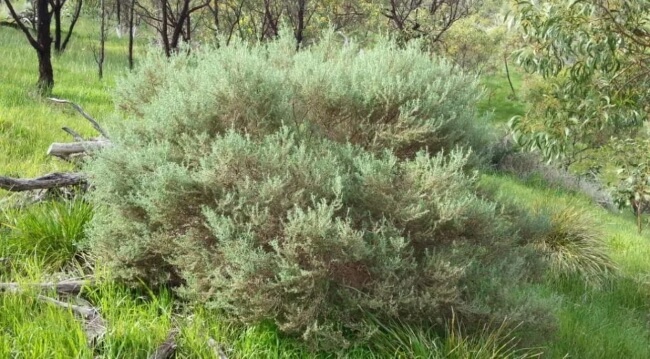
Source: Burnside Biodiversity
Olearia, commonly called the Daisy Bush, is a very varied genus, including trees, shrubs, and herbaceous perennials that die back to the ground in winter. Tree forms are rare for garden use, so early all woody varieties in garden centres will be shrub-form Olearia, and require nearly no care.
Give them plenty of sun, gritty but rich compost and an annual mulch of garden compost to boost flowering, and these stunning members of the aster family will just keep excelling, year after year.
Explore the unique world of Olearia with insights from our detailed Olearia growing guide.
13. Alyogyne
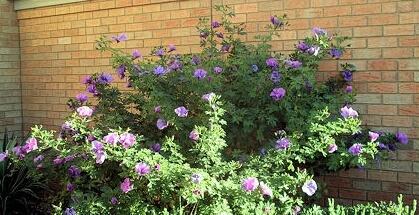
Alyogyne were formerly classified as a member of the hibiscus family, but are now recognised separately thanks to clear distinctions in flower form.
They are the closest thing to dog roses that we can grow in Australia without excessive irrigation, but with the benefit of tightly domed natural structure that means they barely need pruning, and once established offer permanence and evergreen height.
14. Buckinghamia
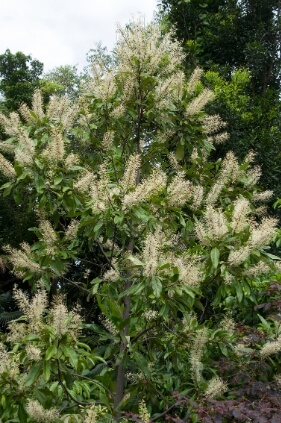
There are two species of Buckinghamia. The first, B. celsissima, is known as Ivory curl, thanks to wonderfully twisted flowers arranged in a neat cone. Ivory curl grows to a maximum height of about 10m and can be easily pruned into a loose hedge, either with annual trims or by deadheading flowers and cutting new growth selectively.
The second, B. ferruginiflora, or Noah’s Oak, is a threatened species in the wild, so not generally available for garden use.
15. Telopea
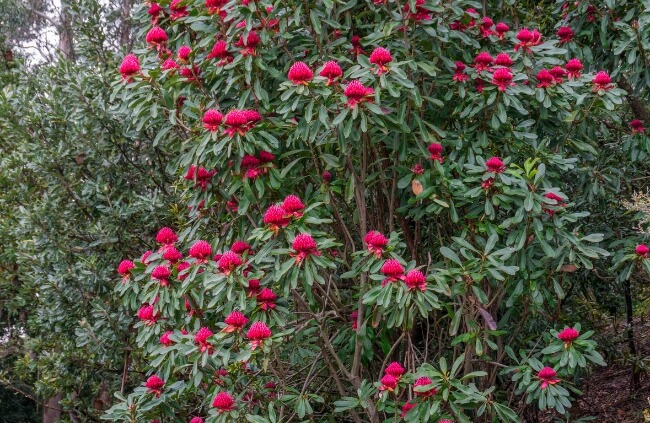
Teleopa, the genus best known as Waratah, the state flower of New South Wales, have huge round, domed flowers, with vivid red and purple tones.
There are just five species of these small trees and Australian bushes, and all can be grown in most Australian gardens, but some are better suited to more humid tropical or exposed locations than others.
Provided they have good drainage and plenty of nutrients available they can thrive on any soil other than damp clay and will even grow with some restriction in large pots for more tightly contained bushes.
For more growing and caring tips for Telopea, read our full Telopea guide.
Caring for Australian Bushes
Once you’ve chosen your Australian bush, it’s worth checking out the more detailed articles on how to grow them, as we have published comprehensive grow guides for most of our favourite native plants.
There are a few simple considerations that run across the board on nearly all Australian natives. For example, how tall do you want your shrub to be, and how do you keep it natural without allowing it to take over the garden?
This is particularly true of taller bushes like banksia or acacia, which can even be pruned into a tree form, and some species will reach over 8m tall. For many, it’s a simple case of pruning with hedge trimmers but, for others, you’ll need to carefully prune back to a natural division along a branch to maintain a good shape.
For all Australian native bushes, when you first plant them, they should be watered in generously, so the soil (whatever type) has good contact with the roots. For most, once established, they won’t need watering other than through extreme and uncharacteristic droughts.
Differences in Australian Bushes by Location
We’ve put together a list of thirteen incredibly native Australian bushes to grow at home below, but if you’re interested in the biology, we’ve also run through what makes them tick, based on where these plants are from in Australia.
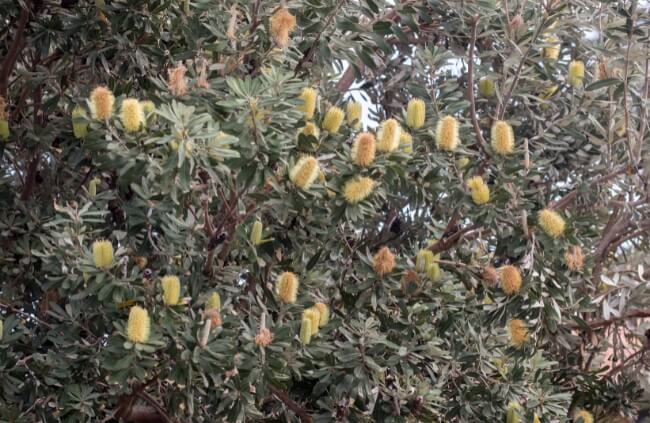
Growing Australian bushes from WA
Most of WA is made up of a surface layer of sandy soil over clay. Some have potent iron oxide content (hence the familiar red soils of the region).
In parts of WA, the sand becomes closer to grit or gravel, and in both cases, the plants that grow here adore free-draining conditions. Some, like banksia, do like a good level of moisture, and will search deep for the moisture retained by clay subsoils.
Recreating that in your garden is simple, just make sure they never get too wet. Natural conditions in WA are low-nutrients too, so the famous phosphorus toxicity in native plants should be observed with most WA native bushes.
Growing Australian Native Bushes from NSW
NSW has a wide mix of soils, but the alluvial soils, having carried nutrients, clays, and minerals down from the hills centuries ago provide rich materials for Australian bushes to grow.
It’s probably the easiest part of Australia to grow in, but what you grow here will be defined by whether you have red soils (iron rich, well drained), or black soils (fertile and moisture retentive).
Growing Australian Shrubs from Tasmania
Tasmania soil is mineral-rich, but nutrient-low, being based mostly on reddish-brown volcanic basalt. It drains well but is also easy to compact, so plants from Tasmania, as well as preferring cooler winters, are often quite fine and deep-rooted, which helps them to anchor into more exposed conditions.
Again, this isn’t an all-encompassing rule, but offers a general idea of what to expect from Tasmanian native bushes.
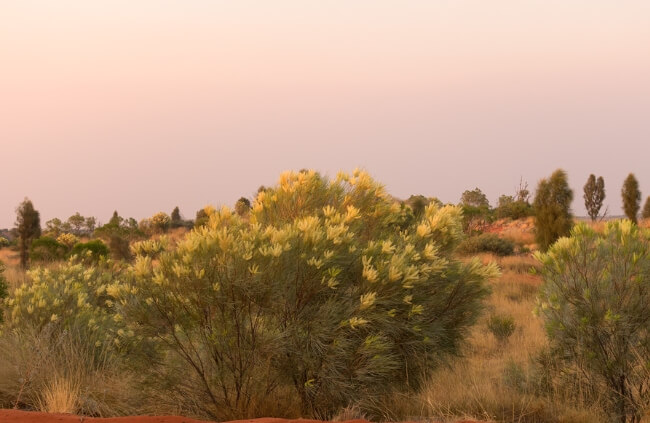
Growing Australian Native Shrubs from Victoria
Victoria has exceptionally rich soil, with good moisture retention through a mix of clay and loamy materials, generally producing dark, black soils.
The closer to the coast you get, the freer the drainage becomes, and the plants here vary hugely thanks to this discrepancy. Coastal native bushes in Victoria are well adapted to free draining conditions, and high exposure. Inland bushes tend to be more subtle in flower, but have better, more structural shapes.
Growing Australian Bushes from SA
South Australian soil is particularly free-drainage, gritty, and low in nutrients. Any Australian bushes that grow here are fine leaves to reduce moisture loss, and need very free-draining conditions in our gardens.
Growing Australian Native Bushes from Queensland
Queensland has mostly clay soils, which can be a blessing and a curse. In damp conditions they are known for high water retention and waterlogging. In dry conditions, they are known for cracking.
Plants that grow in Queensland are generally hardy enough to cope with most Australian climates and soils. If you’re in Queensland and hoping to grow native bushes from other parts of Australia, it’s probably worth some soil amendments like gypsum to maintain soil structure at even levels all year round.
Common Problems When Growing Native Plants
Native plants come with native problems. While some, like eucalyptus, are very good at warding off pests, others, like banksia, actually have quite specific types of insects that eat their leaves, or damage flowers to access nectar.
There’s not much you can do about it, other than persevere with pest control, and the more natives you grow, the more diverse your garden wildlife will be. In time, most pest problems on native plants begin to control themselves.
Frequently Asked Questions About Australian Bushes

What is the most popular native bush in Australia?
Eucalyptus is the most commonly grown native bush in Australia. It’s easy to grow, quick to establish and offers a beautiful scent on warm days.
What is Australia’s national plant?
Golden wattle (Acacia pycnantha Benth) is Australia’s national plant, showing just how important shrubs and bushes are to us as a nation, and how well they define both our ancient and modern histories.
What Australian bushes have yellow flowers?
There are tons of beautiful Australian bushes with yellow flowers, including Golden Wattle, native rosella, yellow hakea and Cootamundra wattle. All offer brightness on the dullest days and are worth growing at home for stand-out colour.
What Australian bushes have red flowers?
One of the best groups of Australian bushes is Banksia, which mostly offers red and orange flowers, adding fiery hits to any border.
What is a fast growing evergreen bush in Australia?
Perhaps the best Australian bush to plant if you want fast impact is Lilly Pilly. It’s amongst the fastest-growing plants in Australia, and is evergreen too. Perfect for creating a quick hedge or neighbour barrier.
Wrapping Up Our Australian Bushes Guide
Australian native bushes are always worth growing, offering a sense of place to your garden that simply can’t be captured with non-natives. I firmly believe that gardens responding to their setting sit better, and connect more mindfully to their location.
This doesn’t just help the garden, but it invariably makes gardens feel bigger and more established faster, often building instant relationships with views over the fence and in the distance.
But, regardless of what I think, you can’t deny that Australian bushes are beautiful and worth a spot in your garden, so go out and find the right one for you.
Published on October 12, 2023 by Nathan Schwartz
Last Updated on October 4, 2025





